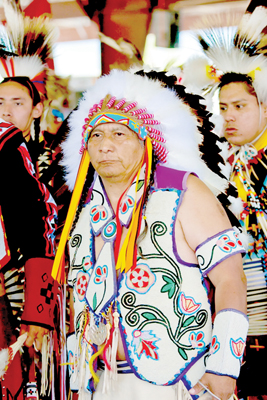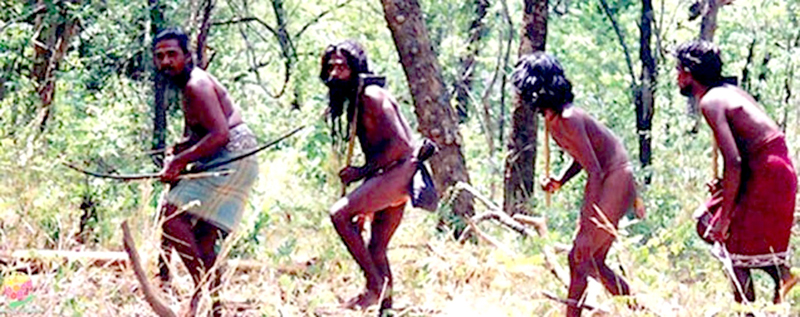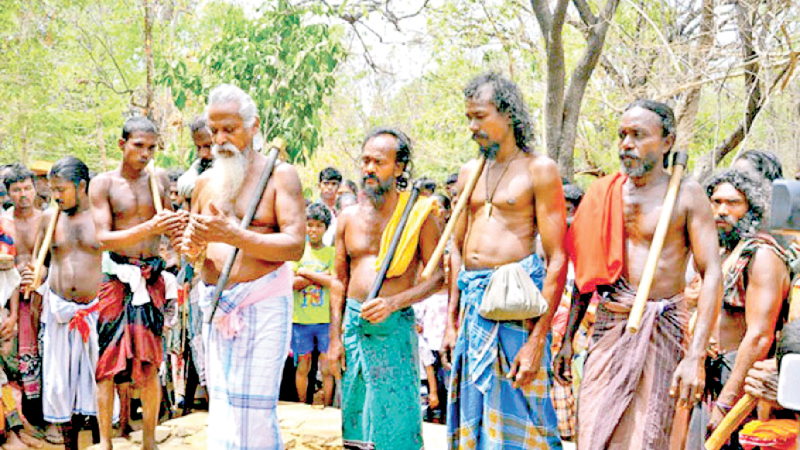 They are the First People. They have usually been in a given region for centuries, even thousands of years, before the arrival of the ‘Others’. But all over the world, the ‘Others’ have trampled on their rights, their lands and even their very lives. And some of them do face extinction in just a few decades, if not years. This is the story of the world’s 480 million indigenous people or First Nation people, including the Wanniyela Aththo of Sri Lanka.
They are the First People. They have usually been in a given region for centuries, even thousands of years, before the arrival of the ‘Others’. But all over the world, the ‘Others’ have trampled on their rights, their lands and even their very lives. And some of them do face extinction in just a few decades, if not years. This is the story of the world’s 480 million indigenous people or First Nation people, including the Wanniyela Aththo of Sri Lanka.
There are various definitions for indigenous peoples, but this version from the United Nations is widely accepted: “Indigenous populations are composed of the existing descendants of the peoples who inhabited the present territory of a country wholly or partially at the time when persons of a different culture or ethnic origin arrived there from other parts of the world, overcame them, by conquest, settlement or other means, reduced them to a non-dominant or colonial condition; who today live more in conformity with their particular social, economic and cultural customs and traditions than with the institutions of the country of which they now form part, under a state structure which incorporates mainly national, social and cultural characteristics of other segments of the population which are predominant.”
There are an estimated 480 million Indigenous Peoples in the world living across 90 countries. They make up less than 6 percent of the world’s population, but account for at least 15 per cent of the poorest. They speak an overwhelming majority of the world’s estimated 7,000 languages and represent 5,000 different cultures.
Indigenous Peoples’ territories encompass 28 percent of the surface of the globe and contain 11 percent of the world’s forests. They are guardians of most of the world’s remaining biodiversity. Indigenous Peoples’ food systems have high levels of self-sufficiency, ranging from 50 percent to 80 percent in food and resource generation.
Sharing common problems
Indigenous Peoples are inheritors and practitioners of unique cultures and ways of relating to people and the environment. They have retained social, cultural, economic and political characteristics that are distinct from those of the dominant societies in which they live. Despite their cultural differences, Indigenous Peoples from around the world share common problems related to the protection of their rights as distinct peoples.
 Indigenous Peoples have sought recognition of their identities, their way of life and their right to traditional lands, territories and natural resources for decades. Yet, throughout history, their rights have been violated with impunity. Indigenous Peoples today, are arguably among the most disadvantaged and vulnerable groups of people in the world. The international community now recognises that special measures are required to protect their rights and maintain their distinct cultures and way of life.
Indigenous Peoples have sought recognition of their identities, their way of life and their right to traditional lands, territories and natural resources for decades. Yet, throughout history, their rights have been violated with impunity. Indigenous Peoples today, are arguably among the most disadvantaged and vulnerable groups of people in the world. The international community now recognises that special measures are required to protect their rights and maintain their distinct cultures and way of life.
A Decade for Action and Dignity
To raise awareness of the needs of these population groups, every August 9 commemorates the International Day of the World’s Indigenous Peoples, chosen in recognition of the first meeting of the UN Working Group on Indigenous Populations held in Geneva. It was first proclaimed by the General Assembly in December 1994, to be celebrated every year during the first International Decade of the World’s Indigenous People (1995 – 2004). In 2004, the Assembly proclaimed a Second International Decade, from 2005 – 2015, with the theme of “A Decade for Action and Dignity.”
The situation of indigenous peoples in many parts of the world is critical today. Poverty rates are significantly higher among indigenous peoples compared to other groups. While they constitute just five percent of the world’s population, they are 15 percent of the world’s poor. Most indicators of well-being show that indigenous peoples suffer disproportionately compared to non-indigenous peoples.
Indigenous peoples face systemic discrimination and exclusion from political and economic power; they continue to be over-represented among the poorest, the illiterate, the destitute; they are displaced by wars and environmental disasters; indigenous peoples are dispossessed of their ancestral lands and deprived of their resources for survival, both physical and cultural; they are sometimes robbed of their very right to life. Indigenous peoples see their traditional knowledge and cultural expressions marketed and patented without their consent or participation.
Around 200 groups of Indigenous Peoples currently live in voluntary isolation and initial contact. They reside in remote forests rich in natural resources in Bolivia, Brazil, Colombia, Ecuador, India, Indonesia, Papua New Guinea, Peru and Venezuela. Just klast month, researchers came across an uncontacted tribe in South America. They choose to live detached from the rest of the world and their mobility pattern allows them to engage in gathering and hunting, thereby preserving their cultures and languages.
These people have a strict dependency on their ecological environment. Any changes to their natural habitat can harm both the survival of individual members and the group as a whole. In fact, any contact with the so-called “civilised” world could expose them to diseases such as Covid-19, with disastrous consequences, as they might not have immunity against diseases that are considered to be common elsewhere, as explained below.
Unique challenges
Despite their right to autonomy as enshrined in the UN Declaration on the Rights of Indigenous Peoples, Indigenous Peoples in voluntary isolation and initial contact face unique challenges often overlooked by the surrounding world. Developments for agriculture, mining, tourism and natural resources in their territories is resulting in the deforestation of swathes of Indigenous Peoples’ forests, disrupting their way of life and destroying the natural environment that they have protected for generations. This has been observed in the Amazon and elsewhere.
For Indigenous Peoples living in voluntary isolation and initial contact, one of the most serious threats from external contact is the exposure to diseases. Due to their isolation, they do not have the immunological defenses to relatively common diseases. Subsequently, forced contact with the outside world can lead to devastating consequences, and can destroy whole societies.
The International Day of the World’s Indigenous Peoples 2024 focuses on ‘Protecting the Rights of Indigenous Peoples in Voluntary Isolation and Initial Contact’. Indigenous Peoples in voluntary isolation and initial contact are the best protectors of the forest. Where their collective rights to lands and territories are protected, the forests thrive, alongside their societies. And not only is their survival crucial to the protection of our planet, but it is crucial to the protection of cultural and linguistic diversity. In today’s hyper-connected world, the existence of Indigenous Peoples in voluntary isolation and initial contact is a testament to the rich and complex tapestry of humanity, and it is a huge loss to our world if they cease to exist. We do need to study their lifestyles and customs without harming them in the process. Thus, it is a tightrope walk.
The story of ‘Vanniyela Aththo’
The plight of indigenous people has received worldwide attention. Here in Sri Lanka, we are familiar with the tribulations of our own Adivasis or ‘Vanniyela Aththo’, who are struggling to maintain their identity and traditional way of life amidst a rapidly developing, commercialised society. There are subtle attempts to assimilate them to the “normal” society, but it is also true that some of the younger members of the clan have voluntarily left the nest for education or work in other parts of Sri Lanka or even abroad. This could reduce their gene pool in the years ahead and threaten their very existence. It is vital to look at their problems and strive to preserve their values, languages and traditions. Once an indigenous community becomes extinct, humanity as a whole loses a part of its soul.
Of the some 7,000 languages today, it is estimated that more than 4,000 are spoken by indigenous peoples. Language specialists predict that up to 90 per cent of the world’s languages are likely to become extinct or threatened with extinction by the end of the century. Some indigenous populations are down to just a handful of people, with no new births. One or two indigenous languages are down to one native speaker, who will take it to the grave.
Although the state of the world’s indigenous peoples is alarming, there is also cause for optimism. The international community increasingly recognises indigenous peoples’ human rights, most prominently evidenced by the UN Declaration on the Rights of Indigenous Peoples. Indigenous peoples themselves continue to organise for the promotion of their rights. They are the stewards of some of the world’s most biologically diverse areas and their traditional knowledge about the biodiversity of these areas is invaluable. As the effects of climate change are becoming clearer, it is increasingly evident that indigenous people must play a central role in developing adaptation and mitigation efforts to this global challenge.
From the Inuits in Canada to the Aborigines in Australia, indigenous communities are facing challenging times and issues. Many indigenous people are being pushed out of their territories as industries, settlements and roads encroach on their traditional lands and in some cases, hunting grounds. Many Governments almost force indigenous communities to ‘integrate’ with the rest of the society, which essentially means giving up on their traditional way of life. There is also defection from within – some of the younger indigenous persons opt for integration, as the above example from Wanniyela Aththo shows. This can, over the years, have a detrimental effect on the community concerned, with men and women of child bearing age leaving in search of a more modern lifestyle.
Contacted or uncontacted, many indigenous communities face extinction, which, of course, means that their languages and customs would be lost forever. They will also take to the grave a vast treasure trove of knowledge about everything from native cures to native art. It is in our interest to ensure their perpetuity for posterity.










